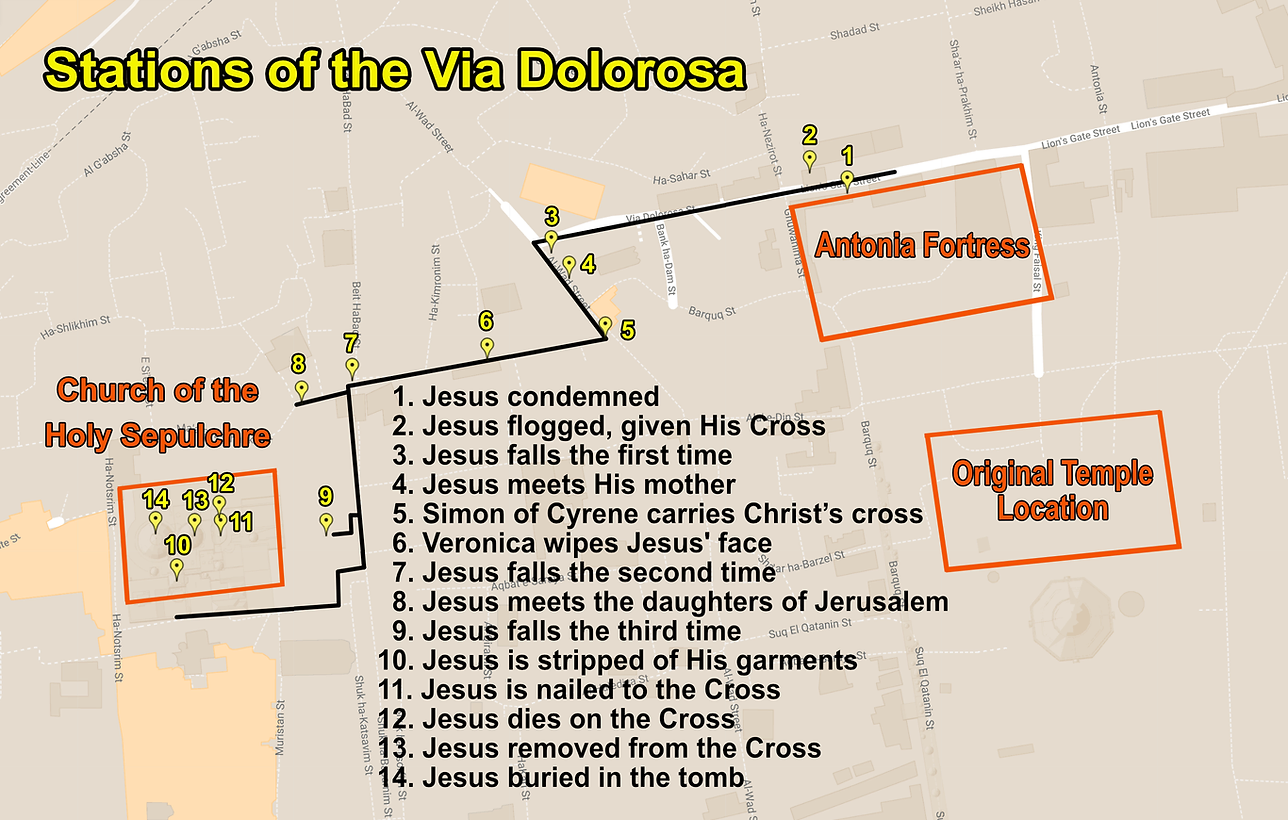The width of this legendary route, the Via Dolorosa, is only about ten feet, but the winding length is about 600 meters (just less than 2,000 feet, or by U.S. reckoning, 20 football fields). Why walk this path? What is its significance? Is the Via Dolorosa in the Bible or built on later legends?
What is the Via Dolorosa?
The Via Dolorosa is a Latin phrase meaning, Sorrowful Way or Way of Suffering. The Via Dolorosa marks a plausible trail our Lord Jesus took as He carried His cross to Calvary.
I had the rare privilege of walking the Via Dolorosa (in Old Jerusalem) with a group led by my pastor and an Israeli archaeologist/tour guide. I took in the beige stone buildings, overhanging greenery, and brightly colored canopies draped across some of the walkways. The sounds of the day were of shop-owners hawking their goods from open-fronted stalls. I asked our tour guide what the Via Dolorosa probably looked like when Jesus walked it as He dragged His cross to Golgotha. She replied, “Oh, much the same.”
Standing on it, I shut my eyes and imagined the gawking crowd hurling insults at our Lord as He fixed His holy eyes on the path set before Him by the Father (Hebrews 12:2). Crucifixions were the norm for that time and place. Thousands of people endured the scourging, humiliation, and death by asphyxiation wrought by the heinous form of punishment. Crucifixion sites were usually close to a road to dissuade would-be offenders.
Shopkeepers and their clients who witnessed Jesus as He trudged past perhaps paid Him little attention because of the frequency with which the practice occurred. However, as in any age, there are people who choose to disparage the suffering person, no matter what their situation. We can assume there were mockers on the Friday that Jesus walked to his crucifixion.
The Via Dolorosa Stations of the Cross
A distinct difference exists between the Via Dolorosa and the Via Crucis. Via Crucis is a Latin phrase that means Stations of the Cross or Way of the Cross. Its name refers to the images marking each point along the Via Dolorosa, where a specific action is presumed to have occurred. The reference points are also called the stations of the cross and are marked along the Via Dolorosa. Tradition states the specific stations of the cross are where:
(1) Jesus was condemned to death. Established at this station is the Madrasa al-Omariya school, which lies a little over 300 yards west of the Lion’s Gate (one of eight gates in the wall of Jerusalem).
(2) Jesus was made to bear the cross. This stop is next to the Franciscan Monastery of the Flagellation. Within the monastery are the Chapel of Condemnation (which marks the site where Jesus received His death sentence) and the Chapel of Flagellation (where Roman soldiers beat Him).
(3) Jesus fell for the first time.
(4) Jesus saw His mother, Mary. The Armenian Church of Our Lady of the Spasm indicates this stop. In it is a fifth-century mosaic that includes a pair of sandals said to be placed upon the footprints of Mary.
(5) Simon of Cyrene is forced by Roman soldiers to carry the cross. This station sits at the same location as a small Franciscan church dedicated to Simon the Cyrene.
(6) Veronica wiped Jesus’ face. The Bible doesn't mention Veronica. She is a fourteenth-century legend created from an early Christian icon.
(7) Jesus fell a second time.
(8) Jesus met the women of Jerusalem (Luke 23:27-31). This spot falls where a cross and a Greek inscription NIKA are etched on the wall of the Greek Orthodox Monastery of St. Charalambos.
(9) Jesus fell a third time (designated by a Roman pillar). This is the last station outside the Church of the Holy Sepulcher. Located in this stop is the Coptic Patriarchate, the center of the Coptic church in Jerusalem.
(10) Jesus was stripped of His garments.
(11) The Crucifixion site where Jesus was nailed to the cross.
(12) The cross where Jesus died.
(13) Jesus’ body was removed from the cross, marked by the statue of Our Lady of Sorrows.
(14) Jesus was laid in the tomb.
It must be mentioned again there is no historical evidence (from the Bible or elsewhere outside of tradition) that these points are exact or all the events are true
Map of the Via Dolorosa
Holy Land Site provides this map of the Via Dolorosa route:

Fourteen stops mark the Via Dolorosa, and different faiths highlight certain customs over others. The last five stations are located in the Church of the Holy Sepulcher, which may or may not be the site of the Lord’s crucifixion. The traditions espoused by the route of the Via Dolorosa are mostly outside the Bible. For Christians walking along the Via Dolorosa, the significance lies in remembering what Christ did for us, not in each event’s exact location. Prayer and reflection are prominent reasons why many traverse the Via Dolorosa.
Along the way where Jesus stooped under the weight of His cross are seven events are based upon biblical events, while seven events are not. Three of these events not detailed in Scripture are Jesus falling as he carried the cross. Others include stations four and six of the Via Crucis. At station four, Jesus was said to have met His mother. At station six, where Jesus was thought to have had His brow wiped by a woman named Veronica. Tradition states she gave Jesus her handkerchief, and He handed it back after wiping His brow. It is said that the image of His face remains on the piece of cloth, now housed in St. Peter’s Basilica in Rome. Again, neither of these two accounts appears in the Bible.
The Scriptures do tell us two events pointed out on the Via Dolorosa did in fact happen on Jesus’ way to Golgotha. Station five is marked as where the Romans enlisted Simon of Cyrene to carry the cross (Mark 15:21). Station eight is marked as where Jesus, speaking to the women following Him, declared about the coming generation of Jews (Luke 23:27-31).
Creation of the Via Dolorosa Route
Christians through the ages have taken pilgrimages to Israel to breathe the air Jesus breathed and walk in the steps of Jesus. Franciscan monks named the Via Dolorosa in the fourteenth century. They sought a name for the pathway between the Antonia fortress and Golgotha. The Antonia fortress is believed to be the site of Pontius Pilate’s praetorium, where Jesus’ trial took place.
Due to competing route-makers, the marked route of Jesus’ path changed many times. Pope Clement VI established the Via Dolorosa as official in the fourteenth century, though the current route was formulated in the eighteenth century. Visitors may walk the course independently or join in many available tours.
Importance of the Via Dolorosa Today
The Via Dolorosa and the Via Crucis are both deeply treasured traditional sites. Neither is biblical in the sense of being practices commanded by the Lord. Their power is held by believers who mark what happened to our Lord Jesus as Roman soldiers led Him to Golgotha. Pilgrims often visit during the week leading to Resurrection, taking extra time to reflect on how Jesus suffered and what His suffering and death mean to us.
The Via Dolorosa in the Bible
Jesus is Condemned to Death (Luke 23:13-25)
Pilate called together the chief priests, the rulers and the people, and said to them, “You brought me this man as one who was inciting the people to rebellion. I have examined him in your presence and have found no basis for your charges against him. Neither has Herod, for he sent him back to us; as you can see, he has done nothing to deserve death. Therefore, I will punish him and then release him.”
But the whole crowd shouted, “Away with this man! Release Barabbas to us!” (Barabbas had been thrown into prison for an insurrection in the city, and for murder.)
Wanting to release Jesus, Pilate appealed to them again. But they kept shouting, “Crucify him! Crucify him!”
For the third time he spoke to them: “Why? What crime has this man committed? I have found in him no grounds for the death penalty. Therefore I will have him punished and then release him.”
But with loud shouts they insistently demanded that he be crucified, and their shouts prevailed. So Pilate decided to grant their demand. He released the man who had been thrown into prison for insurrection and murder, the one they asked for, and surrendered Jesus to their will.
Jesus takes up the Cross (Mark 15:20)
And when they had mocked him, they took off the purple robe and put his own clothes on him. Then they led him out to crucify him.
Simon of Cyrene helps Jesus to carry his Cross (Luke 23:26)
As the soldiers led him away, they seized Simon from Cyrene, who was on his way in from the country, and put the cross on him and made him carry it behind Jesus.
Jesus meets the women of Jerusalem (Luke 23:27-31)
A large number of people followed him, including women who mourned and wailed for him. Jesus turned and said to them, “Daughters of Jerusalem, do not weep for me; weep for yourselves and for your children. For the time will come when you will say, ‘Blessed are the childless women, the wombs that never bore and the breasts that never nursed!’ Then “‘they will say to the mountains, “Fall on us!”
and to the hills, “Cover us!”’
For if people do these things when the tree is green, what will happen when it is dry?”
Jesus is Crucified (Luke 23:33)
When they came to the place called the Skull, they crucified him there, along with the criminals—one on his right, the other on his left.
Jesus dies on the Cross (Luke 23:44-46)
It was now about noon, and darkness came over the whole land until three in the afternoon, for the sun stopped shining. And the curtain of the temple was torn in two. Jesus called out with a loud voice, “Father, into your hands I commit my spirit.” When he had said this, he breathed his last.
Jesus is placed in the Tomb (Luke 23:50-54)
Now there was a man named Joseph, a member of the Council, a good and upright man, who had not consented to their decision and action. He came from the Judean town of Arimathea, and he himself was waiting for the kingdom of God. Going to Pilate, he asked for Jesus’ body. Then he took it down, wrapped it in linen cloth, and placed it in a tomb cut in the rock, one in which no one had yet been laid. It was Preparation Day, and the Sabbath was about to begin.
Further Reading:
What Are the Stations of the Cross and Their Importance?
What Happened to Simon of Cyrene, the Man Who Carried Jesus' Cross?
Photo Credit: ©GettyImages/ Bernhard Richter

Learn more about the meaning and significance behind the Easter holiday and Holy Week celebrations:
What is Lent? and When Does Lent Start?
What is Ash Wednesday? and When is Ash Wednesday?
What is Palm Sunday?
What is Maundy Thursday?
What is Good Friday? and When is Good Friday?
What is Holy Saturday?
What is Easter? and When is Easter Sunday?
Easter Bible Verses
The Resurrection of Jesus
Easter Prayers



